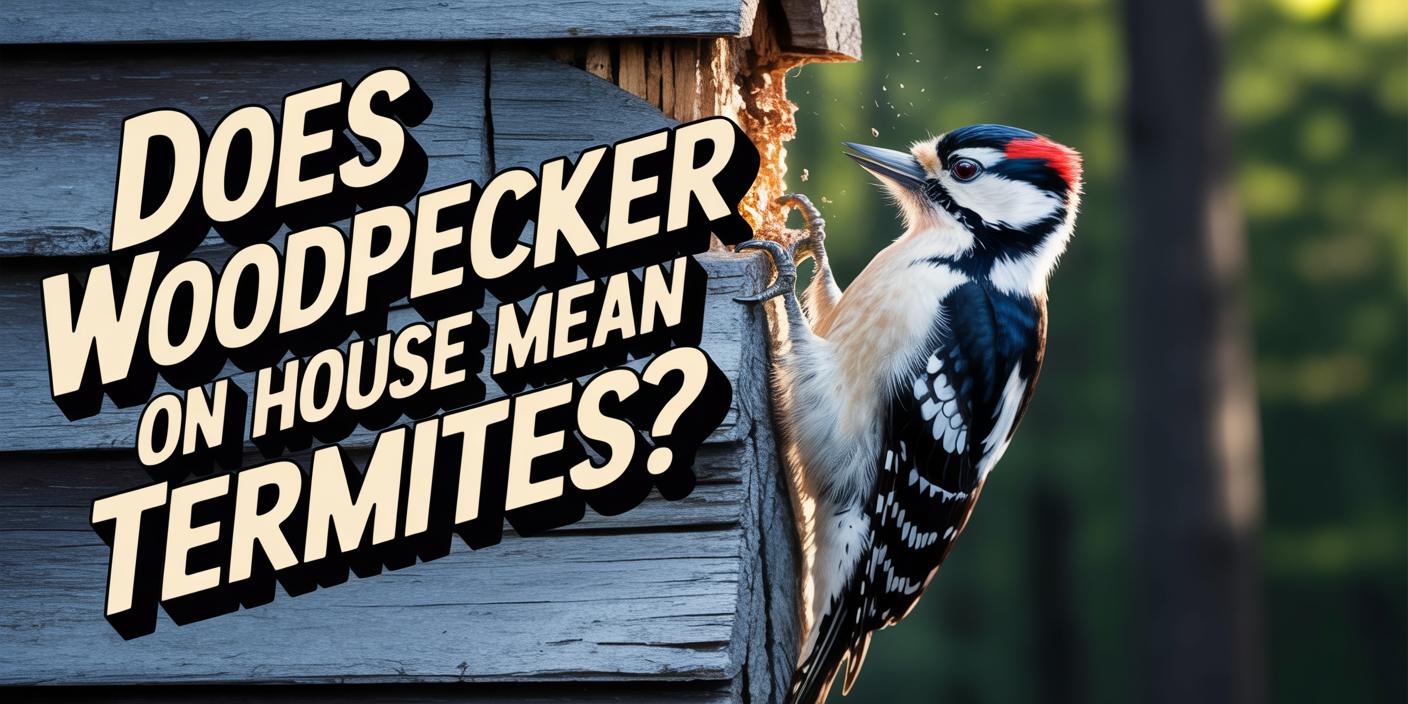A woodpecker pecking on your house doesn’t always mean you have termites, these birds might be after other insects, nesting spots, or even just making noise. It’s smart to check for pest signs, but don’t assume termites are the only reason for their visit.
There’s nothing quite like the sudden, sharp rattle of a woodpecker going to town on your house. For homeowners in Phoenix Arizona, that rhythmic drumming isn’t just an early morning annoyance, it raises a very real question: is a woodpecker on your home a sign of termites lurking inside the walls? With all the buzz about termites and costly damage, it’s easy to jump to the worst-case scenario when a bird shows up uninvited.
Before you panic or grab a ladder, let’s get to the bottom of what woodpecker activity on your house really means. Not every noisy visitor is a red flag for termites, but their behavior can sometimes point to underlying pest problems. Stick around for the expert answers, specific warning signs, and smart next steps every Phoenix Arizona homeowner should know.
Why Woodpeckers Target Houses
Seeing a woodpecker hammering away at your siding doesn’t always signal an invasion of termites. Woodpeckers are drawn to homes for several reasons, many of which have nothing to do with bugs at all. Sometimes they’re searching for a meal, other times they’re looking for a place to nest, or simply establishing their territory by making a little noise.
In Phoenix Arizona, species like the Red-bellied Woodpecker and Downy Woodpecker are known for their curious and persistent nature. These birds are just as likely to drum on metal gutters or wooden trim as they are to look for insects. If your home happens to echo nicely or stands out in their territory, you’ve basically given them a stage for their morning concert. Most woodpecker visits are about what’s convenient; not always what’s crawling underneath the paint.
Woodpeckers and Termites: What’s the Real Connection?
It’s true that woodpeckers eat insects, and termites are definitely on their menu—just not as often as many think. Woodpeckers are opportunistic feeders, and while they’ll go after termites if they find them close to the surface, they’re more commonly after carpenter ants, beetle larvae, or other grubs they can hear or feel moving inside wood.
If a woodpecker is pecking at your home, it doesn’t automatically mean termites are the problem. In many Phoenix Arizona homes, these birds are just as likely to be chasing after ants, wasps, or even spiders hiding in wood siding or eaves. Their drumming could be about bugs, nesting, or even marking their territory, so it’s smart to investigate before jumping straight to a termite infestation.
Decoding the Clues: What Woodpecker Activity Is Really Telling You
Woodpeckers might make a racket, but their behavior can reveal more than just a hunger for bugs. If you want to know if their presence means termites, or something else entirely, start by decoding the specific signs they leave behind. Here’s how to read the evidence like a pro.
1. Woodpecker Hole Patterns: What Do They Mean?
Before you panic, check the type of holes in your house. Woodpeckers leave small, round holes in tidy rows or clusters, often the size of a dime. This organized damage is their signature, not the chaotic tunneling you see with termites.
2. Surface Shavings vs. Hidden Debris: Reading What’s Left Behind
The material left beneath the damage can tell you who’s responsible. If you spot fresh wood shavings or sawdust under new holes, it’s usually a woodpecker at work. Termites leave behind frass, tiny sand-like pellets, and you might also find mud tubes or discarded wings stashed in hidden spots.
3. Tapping and Hollow Sounds: Trust Your Ears
Not all clues are visible, sometimes, the sound gives it away. Tap on the affected area. Hollow or brittle sounds may point to termites silently hollowing out wood, while woodpecker-damaged sections usually remain sturdy except where the bird has been active.
4. Insect Sightings and Swarms: Who’s Really Invading?
What you see crawling or flying around can offer real answers. Termites bring swarms, shed wings, or live bugs clustered near damage, while woodpeckers may be hunting other insects like carpenter ants or beetle larvae just below the surface.
5. Persistent Pecking: When Should You Get Concerned?
If a woodpecker won’t leave one spot alone, it could be signaling a bigger problem. Persistent pecking paired with soft wood or visible insect evidence is your cue to investigate. Otherwise, scattered or occasional peck marks are typically just a normal part of Phoenix Arizona wildlife, not a cause for alarm.
What To Do If Woodpeckers Are Pecking Your House
Woodpecker visits can feel like an emergency, but there’s no need to panic. Taking a smart, step-by-step approach can help you figure out what’s really happening and protect your home from bigger issues.
1. Inspect for Signs of Insects and Damage
Start by closely examining the areas where woodpeckers are active. Look for evidence of insect activity, like mud tubes, frass, soft or crumbling wood, or live bugs under the surface. Don’t forget to check nearby wood trim, siding, and attic spaces for hidden damage. If you only spot small, round holes with no insect clues, termites are probably not the main culprit.
2. Remove Woodpecker Attractants and Protect Vulnerable Areas
Next, make your home less inviting to woodpeckers and pests. Repair damaged wood, patch up holes, and consider installing bird deterrents like reflective tape, netting, or motion-activated devices. Cut back nearby trees and remove standing water to discourage both bugs and birds from hanging around your property.
3. Know When to Call an Expert
If you notice signs of insect infestation or if woodpeckers keep coming back to the same area, it’s time for a professional assessment. AAAC Wildlife Removal can inspect your home for both woodpecker issues and potential termite or pest problems, giving you peace of mind and a tailored solution. A thorough inspection can save you from expensive repairs and lingering worries down the line.
Why Ignoring Woodpecker Activity Is a Risk You Shouldn’t Take
It’s tempting to shrug off a few woodpecker holes or hope the birds will move on. That’s a gamble most Phoenix Arizona homeowners can’t afford. When you ignore woodpecker activity, you’re not just risking cosmetic damage, you could be missing signs of bigger problems that can spiral fast.
- Unchecked woodpecker damage can add up quickly. What starts as a few holes can grow into bigger entry points for water, pests, and even mold, leading to expensive repairs for Phoenix Arizona homeowners.
- Missing an underlying insect infestation is costly. If woodpeckers are after bugs in your walls and you ignore the signs, you could end up with structural damage from termites, carpenter ants, or beetles chewing away out of sight.
- Delaying action can lead to more wildlife problems. Open holes from woodpecker activity make it easier for other critters, like rodents or squirrels, to move in, causing even more chaos and damage.
- Professional help means long-term peace of mind. AAAC Wildlife Removal provides expert inspections to catch both wildlife and insect issues early, protecting your investment and sanity.
Don’t Ignore the Knock—Get Answers
Woodpeckers tapping on your house might be loud, but the real message is even more important. Their visits don’t always point to termites, yet they can highlight issues you can’t afford to overlook. By paying attention to the signs, acting quickly, and calling in experts when needed, you protect your home from pests, costly repairs, and future headaches.
Don’t wait for small problems to become big disasters. If woodpeckers are making your house their hangout, let AAAC Wildlife Removal give you a real answer; and peace of mind.
Take Action with AAAC Wildlife Removal
Ready to put an end to woodpecker worries and protect your home from hidden pests? AAAC Wildlife Removal offers expert inspections and effective solutions for both wildlife and insect problems in Phoenix, Arizona. Don’t leave your house (or your peace of mind) up to chance, schedule a professional assessment today and let our team keep your home safe, sound, and pest-free.
Contact AAAC Wildlife Removal now for a thorough inspection and get answers you can trust. Your home deserves nothing less!




